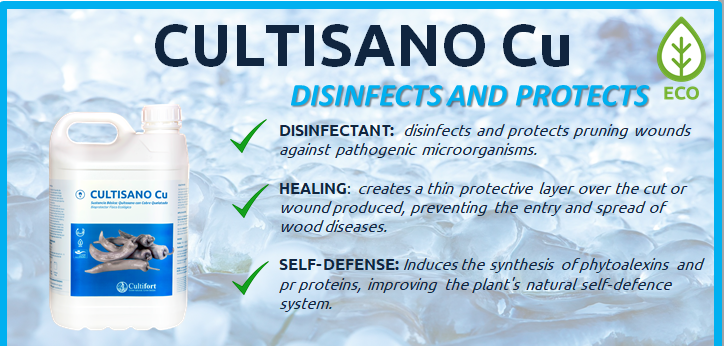Autumn advances, the days become shorter, temperatures drop and, as a consequence, many woody or fruit crops, including vines, are defoliated, thus ending their phase of accumulation of reserve substances and beginning a period of vegetative stop or winter rest. It is time for pruning.
We can define vine pruning as the operation that includes the different cuts and suppressions that are carried out on shoots, branches and herbaceous parts (branches, leaves, bunches, etc.), which are carried out some or all years.
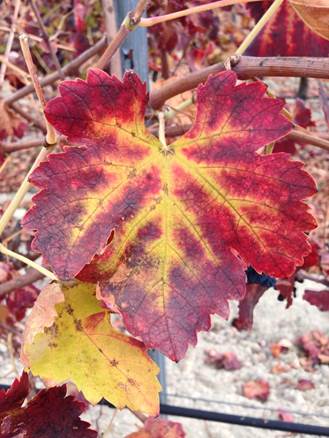
From this definition we can extract that there are different types of pruning. On the one hand we have that which is carried out on the woody parts of the plant (shoots and branches), called dry pruning, and on the other hand that which is carried out on the herbaceous parts (shoots, leaves, bunches, etc.), called green pruning or operations. In our case, and due to the time of year, we are going to treat the first type of pruning described, dry pruning.
For this, we have Jesús Yuste Bombín, a recognized expert in viticulture and oenology not only at a national level but also internationally, who will try to clarify a series of questions about vine pruning.

Jesús Yuste is an Agricultural Engineer (1988), Master in Viticulture and Oenology (1989) and Doctor in Agricultural Engineering (1995), from the Polytechnic University of Madrid; Researcher in Viticulture, since 1990, at the Castilla y León Agricultural Technology Institute (ITACyL); and collaborating professor at various universities: Politécnica de Madrid, Valladolid, Europea Miguel de Cervantes, La Rioja, León, Montpellier. He has spent time at an international level, at CSIRO – Horticulture Division-, Adelaide (Australia), in 1996-1997, and at the University of California -Department of Viticulture and Oenology-, Davis (USA), in 1999. Throughout his professional career he has published more than 200 scientific and technical papers, not only nationally but also in international journals; he has directed numerous final projects, doctoral theses and research grants; he has attended countless congresses and conferences on viticulture and oenology, and has written more than 250 papers for congresses and scientific meetings, as well as being the author, co-author and collaborator of several chapters of books on viticulture (pruning, irrigation, clonal selection, varieties, etc.).
From Cultifort we want to thank him for accepting our invitation and we hope to be able to count on him in other occasions. THANK YOU VERY MUCH!
Let’s start with the most obvious question. What are the goals of pruning?
The basic objectives pursued with the pruning are:
- Form and maintain the vine in a way that facilitates the cultivation of the vineyard.
- Select knots and buds that produce adequately fertile shoots.
- Regulate the number of branches and the number and size of the clusters.
- Regulate vegetative growth.
- Produce grapes of the desired quality.
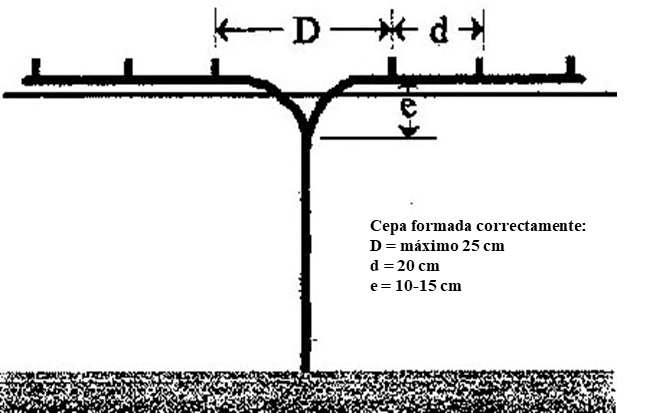
Example of a strain pruned in double cordon according to an ideal scheme
Therefore, within dry pruning, we can make different classifications of the pruning.
Depending on the life stage of the vine and the production objectives, different pruning classifications can be established. As for the life phase, in chronological order, there is Formation Pruning, Maintenance Pruning, Rejuvenation Pruning and, there may be, Transformation Pruning (from one conduction system to another). As for the productive criterion, there can be established basically the Short Pruning and the Long Pruning, depending on the type of fruitful element that is respected in the pruning, thumbs in the short one and rods in the long one, assuming that in most cases the long pruning is usually mixed pruning, because it includes thumbs in addition to the rods that give it the character of long pruning.
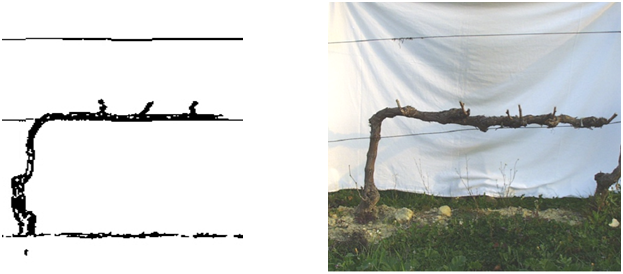
Short pruning system: single cordon (thumbs)
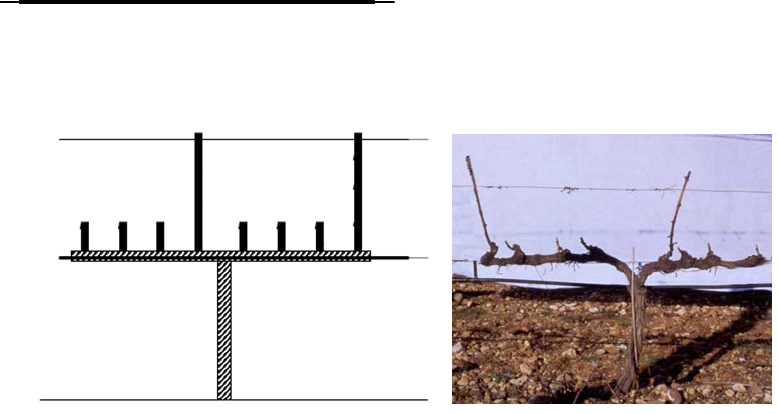
Mixed pruning system: Yuste pruning (thumbs and sticks)
Knowledge of the different types of buds and their fertility is essential to determine the pruning load. Could you talk to us briefly about this?
There is a qualitative difference between the types of buds due to the differential fertility of the buds along the shoots, which must be taken into account when carrying out the dry pruning operation on each stock. The most fertile buds are those that occupy half of the shoot, with fertility decreasing towards the base and the apical part, due to the time and conditions in which the floral initiation processes of each of the buds on the shoot took place, so that in general the most fertile buds are located between the fifth and ninth node. Apart from this appreciation, there are varieties that require different types of pruning due to the low fertility of the buds in the first ranges of the shoot, as is the case with the Verdejo and Prieto Picudo varieties.
It should be clarified that the basal buds or casqueras do not usually contain clusters, except for the most important and bulky, the blind, which usually has one. There are some varieties in which some of these casqueras buds, located in old wood, offer a more pronounced fertility, especially when the previous year the conditions of the prevailing climate were favourable during the phases of growth and constitution of the reserves, which are the periods where the bunches are formed and perfected in the vegetative cones.
It is therefore essential to know the fertility of the buds and their situation, for each variety or class of vine to be pruned.
Only the number of regularly fruitful buds respected in pruning will constitute what we understand by load. The rest, with little or no fertility, are considered to be out of load, although in certain cases they may contribute to production and, of course, serve other purposes, such as rejuvenating an arm or a whole vine.
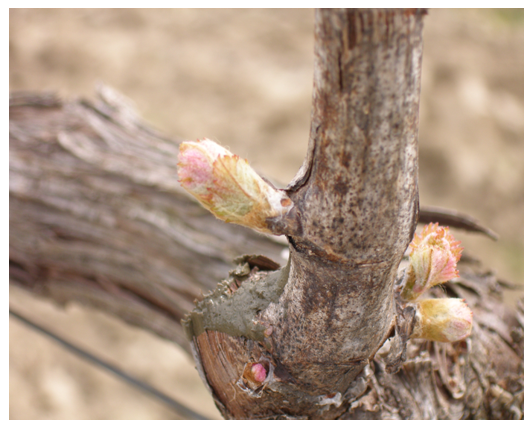
Detail of latent buds and casqueras al onset of sprouting
What is the relationship between the production of a strain and its vegetative activity? In other words, is there a balance between the vigour of a strain and its productive potential?
Vegetative activity supports the productive capacity of the vine, so a balance must be sought between the vigour of the vine and the intended grape production. Once the vine has reached a certain shape and structure, this balance will be achieved by adjusting the number and position of the buds during the pruning operations each year. Increasing the number of buds per vine will result in a greater number of shoots and bunches and will reduce their vigour, which may lead to problems of fruit ripening if the vine is overloaded and weakening of the shoots in later years. Reducing the number of buds per vine will result in fewer but excessively vigorous shoots, with potential loss of harvest and possible shading problems and therefore a reduction in the quality of the grapes.
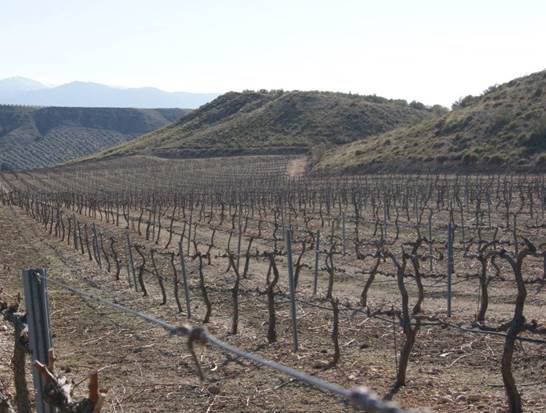
Vineyard pruned to double cordon and double height
What does the vegetative activity or vigor of a shoot or vine depend on?
The growth or vigor of a shoot, called a pompano as long as it remains green (until it wilts and is called a vine shoot), depends:
A. of its position on the thumb or rod, i.e., the range of the shoot where the bud that generates it is located, in a similar way to potential fertility (derived from the degree of differentiation of the bud itself), so that this potential for vigour increases up to the middle zone of the shoot (6th to 10th node), subsequently decreasing at the following nodes, in the most apical part of the shoot. If pruning is done short, with only the thumbs (i.e. a pair of retained buds), this aspect should not be taken into account, as there is hardly any difference between these buds, whereas if pruning is done on poles, this should be considered in order to decide up to which range the buds are to be retained. In such a long pruning, it should be considered that the sprouting of lower rank buds may be reduced to the extent that more buds are retained.
B. of its direction, so that those closest to the vertical are the ones that grow most favourably, i.e. the curving or bending of the vine shoot can help to favour sprouting and the vegetative development of the buds located on the curve itself (more vertical), which would normally be those with the greatest potential fertility.

Does the production of a vine grow in proportion to the number of bunches it carries?
The production of a vine depends on the number and type of buds retained during pruning. The final grape production will depend on the size of the bunches, which in turn will depend on the number of bunches on the entire vine. In other words, the vine tends to balance its productive development in proportion to the initial harvest load, up to a certain threshold, depending on the individual vegetative capacity of the vine, which is ultimately affected by the annual climatic and cultivation conditions. In other words, although a vine’s production grows in proportion to the number of bunches it carries, it does not do so without limit, since it cannot exceed the production corresponding to the plant’s reserves.
The pruning of a vine must be in harmony with the type of vine being cultivated, i.e. it is not the same to prune a vine arbour as a wine grape farm. But does pruning differ depending on the variety?
Dry pruning must be carried out according to the wine variety, given that the fertility of the buds has a highly genetic component, so that there are varieties, sufficiently fertile, such as Tempranillo or Airén, which only need high pruning, while there are other varieties, less fertile, such as Prieto Picudo or Verdejo, which require long or mixed pruning.
On the other hand, trying to obtain high yields with varieties of great quality potential (higher quality) is not recommended since it will lead to a decrease in this quality potential and a general weakening of the vine. Similarly, restricting production potential in varieties with this quality, seeking to increase the quality of the harvest, will rather result in an increase in vigour (wood). Subsequent actions to correct this will lead to an increase in the costs of the crop.
At this point, we are left with one of the most important questions: How should we execute the cuts?
Pruning cuts should be made with the smallest possible section, to avoid large wounds, trying to give a small inclination towards the side opposite the immediate bud when the thumb is in a vertical position. The pruning cut should not be rushed with respect to the immediate bud, respecting a minimum height of 4-5 mm. The pruning cuts should be made as shown in figures 1 and 2 (“correct cuts”). Apart from this, there should be no unnecessary annual renewal of thumbs, especially in the case of conduction systems with permanent cords, to avoid premature ageing of the arms and the stock in general.

In the case of short or long pruning, how do you know which thumb to choose or which stick to leave?
In short pruning, to leave a thumb, the shoot closest to the base should be chosen, to avoid excessive elongation, without being obsessed with choosing badly placed suckers or shoots from the crown, except in situations of necessary renewal of thumbs by accident or excessive elongation.
In the case of mixed pruning (usually considered long), the rod chosen should be left above the renewal thumb, to avoid creating a stream of dry cuts on it that deteriorate the wood of the vine and facilitate the appearance of health problems in it.
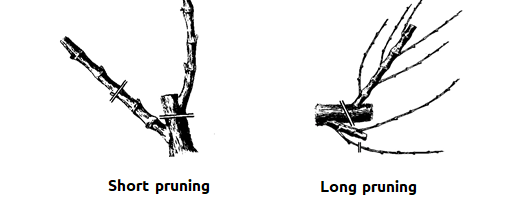
What considerations should we have when choosing a vine shoot to prune like a thumb or a stick?
The choice depends on the driving and pruning system adopted. Within it, it will be done in such a way as to maintain the shape with the least possible deviations. A number of considerations must be taken into account:
- Growth of the wine: with varieties of upright growth, we will look for those that tend to open the vine more or less, in accordance with the climate; in the stunted growth, we will look for those that lift it.
- In hot, dry summer climates, care should be taken to close or pick up the general disposition to avoid accidents.
- Where the summers are rather cool and wet, there will be a tendency to spread the vegetation.
- Do not use pacifiers, except in exceptional cases: frost, modifications due to old age, etc.
- Select the vine shoots with average individual vigour.
- Watch for the new thumb to start, so that it has a firm origin or location.
- Make sure that all the arms have thumbs that are as thick.
- If a rod or sack has been left in any arm, because the vigour of the respective strain and arm allows it, try not to repeat such an extreme in the same arm another year.
- Except in exceptional cases, the closest one should be chosen because of its insertion into the corresponding arm, in order not to produce wounds or injuries below the thumb.
In summary, the choice of the shoot to be left as a thumb or stick must respond to the combination of various criteria: location on the arm (thumb) or head (stick) of the stock, individual vigour, possibility of future renewal, desired production level, etc.
And when making cuts on older wood, what considerations should we take into account?
Cuts on old wood, more than one year old, should be minimised, so that the health of the vine can be preserved as much as possible, as it should be taken into account, in general, that pruning cuts are the fundamental cause of the ageing of the vine and the main route of contamination of diseases in the vine. In situations where renovation is necessary, cuts must be made in such a way as to allow it to be reduced in successive years (1 2), without too much haste for cuts in which the drying out could compromise the life of the respected part (3 4), i.e. tight cuts must be avoided, leaving a sufficiently large piece of protection wood so that the subsequent inevitable drying out does not affect the vascularisation of the arm or trunk, assuming that in subsequent years the dry wood produced by the effect of the renewal pruning cut must be removed.
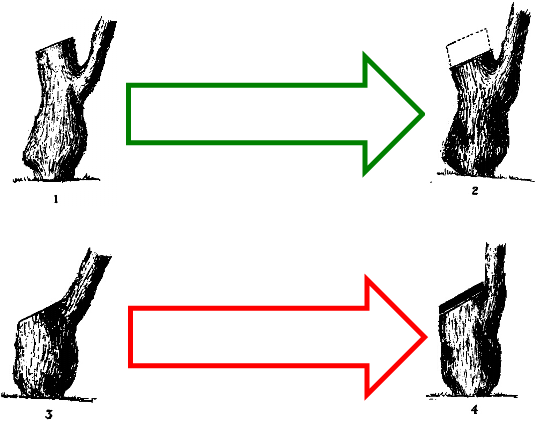
Once we have pruned our vines, is it convenient to carry out some kind of treatment on the cuts made? And on the pruning tools?
It is very convenient to carry out pruning in dry weather, trying to avoid the days before and after the rain. In any case, after the execution of the pruning cuts it is convenient to apply some type of sealant, which can incorporate fungicide materials, to try to reduce the risk of infection through the pruning cuts themselves. In this same sense, the periodic disinfection of pruning tools is highly advisable, with alcohol, bleach, etc…, especially in vineyards where outbreaks of infection by wood fungi are observed, in order to prevent the spread of these wood diseases in the vineyard. In these vineyards, pruning should be carried out, separately and previously, on those vines that have shown symptoms of the disease, removing the remains of the pruning from the vineyard itself as soon as possible.
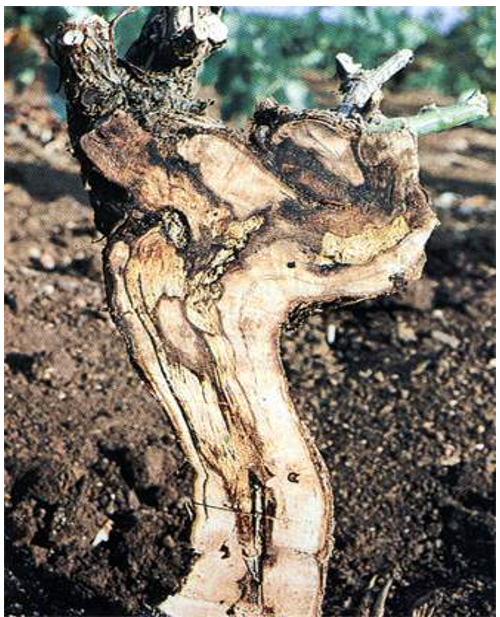
Longitudinal cut of a strain affected by Yesca
Article sponsored by:


